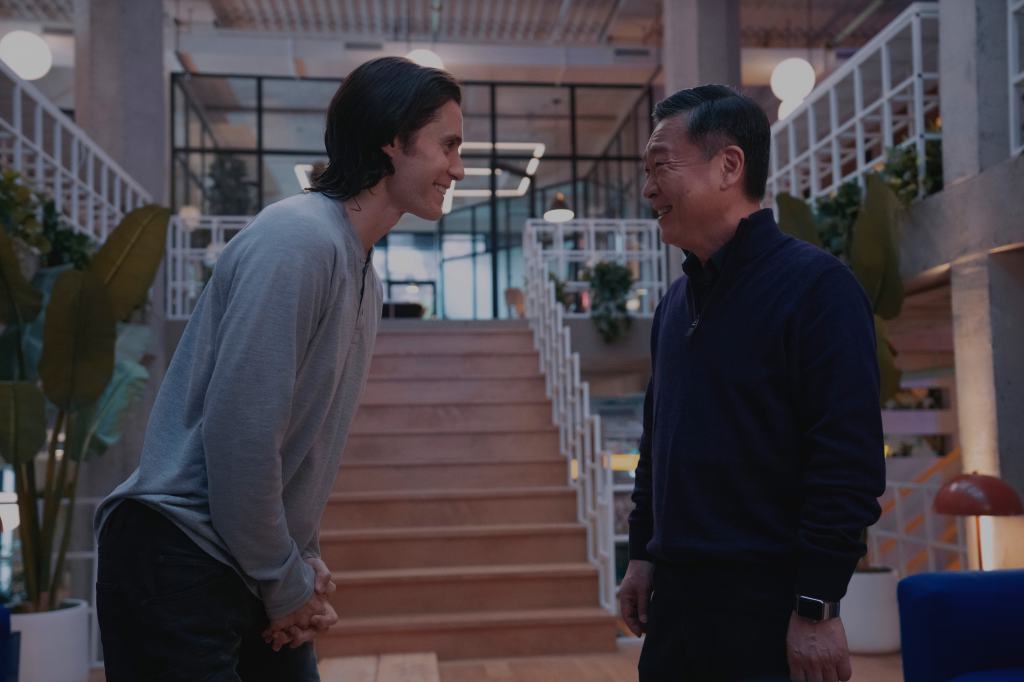When it came to recreating the offices of WeWork, the company that made and lost billions of dollars, production designer Amy Williams was told she could go as big as she possibly could.
The communal office space world is depicted in the Apple TV+ series “WeCrashed,” which comes to an end on Friday. The show charts the rise and fall of founders Adam Neumann, played by Jared Leto, and his wife Rebekah Paltrow Neumann, played by Anne Hathaway.
Williams was excited as a designer to dip into the big, luscious extravagant world. Creators Drew Crevello and Lee Eisenberg mentioned she would have to build the main headquarters set. “I had this idea that I wanted it to be this confusing, M. C. Escher-type staircase [place] that was three stories and confusing,” says Williams. When she pitched it to the showrunners, they loved it. The set ended up being so big, it was treated as a real-building that needed sprinklers and a HVAC system.

Production designer Amy Williams modelled her designs on WeWork offices from around the globe.
Apple TV Plus/Amy Williams
When designing the workpaces, Williams credits WeWork architect Miguel McKelvey. “We cast the net worldwide,” she says for inspiration. “They have a really good pattern at the Paris location. The New York location has the multi-level thing, but with staircases,” she explains.
Love Film & TV?
Get your daily dose of everything happening in music, film and TV in Australia and abroad.
The staircases were important because she wanted to give Leto’s Adam a pulpit which he could preach from. Atop that was his office. “It was this place from on high, so when he had the Monday meetings, he could look down onto his kingdom and look down on his disciples,” Williams said leaning into the grandiose notion with the staircases.

Amy Williams was inspired by the M.C Escher staircase, atop was Adam’s office where he could “preach from.”
Apple TV/Amy Williams
Just as important to her design was the color. Williams worked closely with the show’s costume designers. “We wanted to stay true to what and who these people were in life. My graphics team worked very closely with costume because swag and branding was a big part of what WeWork was,” explains Williams. Early on, the two departments worked closely as they each built their palette. Williams pulled bright primary colors such as bright pinks. “Once we had that template we had something to work off of.”

Pinks and yellows served as the basis of Amy Williams’ color palette.
Apple TV/Amy Williams
Furthermore, she built a WeWork timeline that was color-coded, beginning with earthy, organic, gritty and city-like for the early stages. “That’s when Edison bulbs were popular and reclaimed wood. As the story heightens, and they get more and more successful, it gets brighter and more colorful, and chaotic.” However, as the world begins to crash around them, Williams deliberately stopped the party. “That’s when the palette gets serious. It’s blue, greens and silvers.”
Williams’ favorite problem to solve was the aspect of having a space that is converted into the office space in the script. She didn’t have months to build, just a matter of days. “We found this great building in Brooklyn. We used one floor for the raw space, and we would make it dirty, we added scenic paint everywhere and garbage, and we boarded up the windows. Then we would take over another floor and completely renovate it to the WeWork space with the colorful furniture, the desks and the polished concrete.”
In the end, the office and set spaces were as long as a city block, Williams says, “There was a backyard courtyard that was supposed to be a roof deck, and it had a two-story waterfall, they let us put that in there.”
The set was so big, it was treated like a real building with a sprinkler system installed on every floor. “They coded it as an actual building and not a set. We also needed a HVAC system.”

The “WeCrashed” set was so large, it needed sprinklers and a HVAC system installed.
Apple TV/Amy Williams
From Variety US































